Installing the Virtuoso Universal Server on Mac OS X
- 0 - Prepare to Install
- 1 - Download and Install Virtuoso Binary
- 2 - Obtain a License File
- 3 - Start and Locate the Virtuoso Monitor
- 4 - Apply your License File
- 5 - Start and Administer your Virtuoso Instance
- 6 - Optional - Restore your old Data and Configuration Files
- See Also
0 - Prepare to Install
If you are upgrading an existing Virtuoso installation and want to preserve your existing data and configuration files:
- Shut down your Virtuoso instance as normal.
- Right-click on the existing Virtuoso.app (exact name may vary), and select Show Package Contents.
- Drill down to Contents --> virtuoso --> database.
- Check the size of the
virtuoso.trxfile, found in the database folder alongside thevirtuoso.dbandvirtuoso.inifiles.
- If zero bytes, proceed to step 6.
- If larger than zero bytes, start the instance from the command line with the extra argument, "
+checkpoint-only", and recheck.trxfile size -- expecting zero bytes.
- If larger
.trxfiles persist, contact Technical Support.
- If zero bytes, proceed to step 6.
- Make a backup of your existing Virtuoso Database and Configuration files (defaults are
virtuoso.dbandvirtuoso.ini) prior to performing the steps that follow. You can simply Option-drag (to force a copy) yourvirtuoso.dbandvirtuoso.inifiles to your Desktop, Documents folder, or other preferred location. Note: Virtuoso's online backup feature, if enabled, should have already generated a backup-set.
1 - Download and Install Virtuoso Binary
- Download the Virtuoso 7.2 installer archive (mwvpz2zz.dmg) from the download site.
Note: Virtuoso 7.x requires OS X Lion (10.7) or later.
- Open the
mwvpz2zz.dmgfile, and drag the Virtuoso 7.2.app into your Applications folder or other preferred location.
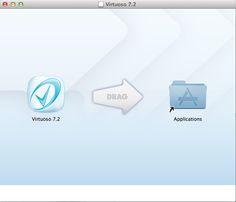
- Once the copy is complete, you can Eject the Virtuoso 7.2 disk, and discard or retain the
mwvpz2zz.dmgfile as you prefer.
2 - Obtain a License File
- If you haven't already obtained a suitable Virtuoso 7.x license file, return to the download site, and click the link for Free Eval License (15 day duration, requires only your email address) or Free Pilot License (30 day duration, requires some additional personal and business information).
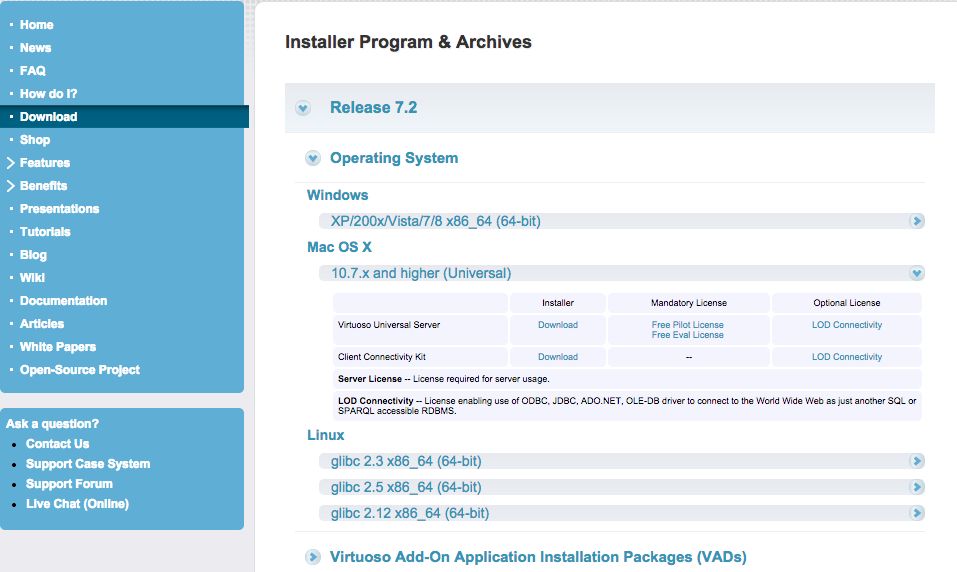
- Fill out the relevant form, and download the license file when presented.
Note -- the file must be named
virtuoso.licfor use. Some browsers may rename the file during download; you can simply rename the file on your Mac.
3 - Start and Locate the Virtuoso Monitor
- Double-click the Virtuoso 7.2.app to trigger installation and startup of helper tools -- the Virtuoso Monitor and
OpenLink License Manager.
- Locate the Virtuoso Monitor in your menu bar -- it's the V icon toward the right.
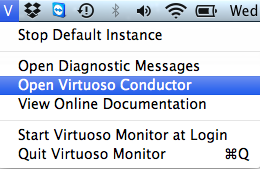
- You may also choose to automatically Start Virtuoso Monitor at Login, or you may prefer to manually start it when needed (by double-clicking Virtuoso 7.2.app, as you just did).
4 - Apply your License File
- In the Finder's Go menu, select Go to Folder..., and input
/Library/Application Support/OpenLink/Licenses
- Drag the license file (
virtuoso.lic) you downloaded above into this folder.
- You may receive a prompt, Modifying "Licenses" requires an administrator name and password. If so, click the Authenticate button, and input a Mac OS X administrator's username and password.
5 - Start and Administer your Virtuoso Instance
- Open the Virtuoso Monitor menu, and select Start Default Instance.
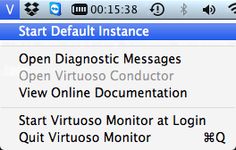
- Open the Virtuoso Conductor, Virtuoso's HTTP-based administration tool, by selecting Open Virtuoso Conductor from the Virtuoso Monitor menu, or by loading this URL in your Web Browser:
http://localhost:8890/conductor.
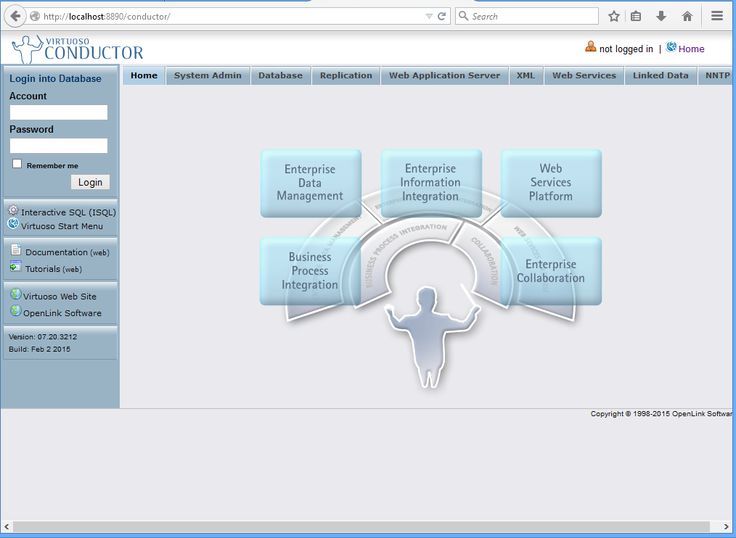
- Use the Conductor to configure your Virtuoso instance for future use.
For example, it is strongly advised that you change the default passwords for the
dbaanddavsuper-user accounts (drill down to System Admin --> User Accounts).
6 - Optional - Restore your old Data and Configuration Files
If you preserved existing data and configuration files at the start of this process, now is the time to bring them back into play.
- If you used Virtuoso's online backup feature, the documentation will walk you through the restoration process.
- If you simply copied the INI and DB files elsewhere, and if they were Virtuoso 7.x files, you can just stop the current Virtuoso instance, and replace the newly created INI and DB with the old ones.
For best results, we do advise that you compare the content of the old INI with the new, and add any new settings from the new to the old, adjust as may be appropriate to your deployment.
- If you simply copied the INI and DB files elsewhere, and if they were Virtuoso 6.x or older files, there are some extra steps that must be taken.